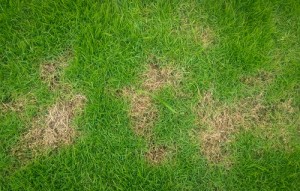How to Prevent Disease and Insects in Your Lawn
Thursday, December 21st, 2017Like people, no lawn is immune to disease and damage. That said, the better you take care of your body (or blades of grass), the more likely it is to live a long, healthy life. On the other hand, if you engage in harmful behaviors, the end result will usually reflect the unkempt lifestyle—even if the detrimental activities were accidental. Thankfully, Arizona, with its dry conditions, doesn’t really have much disease pressure, but there are some activities that can cause problems. Along the same lines, Arizona tends not to have too many issues with insects. On occasion, however, they do make an appearance.

The best way to prevent diseases and unwanted pests is to educate yourself about the possibilities so you can take steps to keep problems from occurring.
What Does Disease Look Like on Arizona Lawns?
Diseases are only caused by environmental stresses like overwatering and too much thatch—problems which can actually be correlated, depending on the situation. Thanks to Arizona’s specifically dry climate, we don’t have the diseases many other parts of the country have, but if you’re overwatering or over-fertilizing, you’re likely causing your lawn stress and inviting diseases.
St. Augustine is a common type of grass in Arizona because it’s quite heat tolerant, allowing it to thrive in the excessive summer heat and sun we see in this part of the country. Unlike many other types of grass, St. Augustine tends to do well on lawns that are well-shaded. Homeowners who have St. Augustine grass often face specific struggles, however. People commonly apply too much nitrogen to St. Augustine grass, which causes too much growth. Additionally, because this grass is often installed on lawns with shady areas, it’s not uncommon for homeowners to overwater in the summer, as shaded areas often require les water than those, which are directly exposed to full sunlight.
Generally speaking, if you water properly, dethatch regularly, and use the appropriate fertilizer for your type of lawn, you won’t have to worry much about diseases.
What Do You Need to Know About Preventing Insect Infestations in Arizona?
There aren’t too many issues with insects in Arizona, but there are times when they can become extremely problematic. Unfortunately, by the time they’re apparent enough for you to know there’s an issue, it’s already too late to stop it. Most of those problems start with insects that lay their eggs in the fall or spring. When the larvae hatch, you suddenly have a grub, moth, or ant problem that seems to come out of nowhere.
One major contributor to large colonies of unwanted pests is thatch. Thatch is the buildup of organic materials such as roots, stems, and leaves that accumulate at the surface of the soil. Regular dethatching is important for two reasons: it breaks up this barrier of matter that prevents moisture and nutrients from reaching the roots of the grass, and it keeps bugs from taking up residence within the matted material. If thatch gets too thick, it can easily become an ideal home for unwanted pests.
Preventative pesticides and regular dethatching should put you on a path to a pretty pest-free property.
The best way to keep insect infestations away is to use preventative insecticide in the spring when it starts to warm up. In Arizona, target April or May for this process since it tends to warm up earlier here than many other parts of the country.
Are you looking for advice from professional lawn care experts? Our Evergreen Turf team lives and breathes beautiful lawns! Check out our Sod Blog for plenty of helpful tips and tricks. Contact us at Evergreen Turf today if you need sod in Phoenix, Tucson or the surrounding areas of Arizona.
